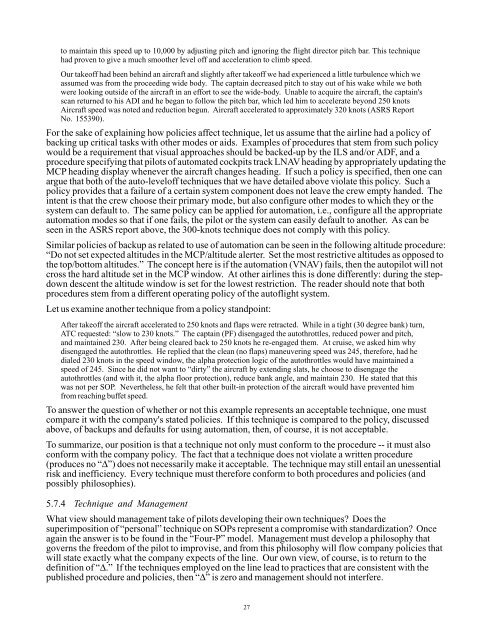On the Design of Flight-Deck Procedures - Intelligent Systems ...
On the Design of Flight-Deck Procedures - Intelligent Systems ...
On the Design of Flight-Deck Procedures - Intelligent Systems ...
Create successful ePaper yourself
Turn your PDF publications into a flip-book with our unique Google optimized e-Paper software.
to maintain this speed up to 10,000 by adjusting pitch and ignoring <strong>the</strong> flight director pitch bar. This techniquehad proven to give a much smoo<strong>the</strong>r level <strong>of</strong>f and acceleration to climb speed.Our take<strong>of</strong>f had been behind an aircraft and slightly after take<strong>of</strong>f we had experienced a little turbulence which weassumed was from <strong>the</strong> proceeding wide body. The captain decreased pitch to stay out <strong>of</strong> his wake while we bothwere looking outside <strong>of</strong> <strong>the</strong> aircraft in an effort to see <strong>the</strong> wide-body. Unable to acquire <strong>the</strong> aircraft, <strong>the</strong> captain'sscan returned to his ADI and he began to follow <strong>the</strong> pitch bar, which led him to accelerate beyond 250 knotsAircraft speed was noted and reduction begun. Aircraft accelerated to approximately 320 knots (ASRS ReportNo. 155390).For <strong>the</strong> sake <strong>of</strong> explaining how policies affect technique, let us assume that <strong>the</strong> airline had a policy <strong>of</strong>backing up critical tasks with o<strong>the</strong>r modes or aids. Examples <strong>of</strong> procedures that stem from such policywould be a requirement that visual approaches should be backed-up by <strong>the</strong> ILS and/or ADF, and aprocedure specifying that pilots <strong>of</strong> automated cockpits track LNAV heading by appropriately updating <strong>the</strong>MCP heading display whenever <strong>the</strong> aircraft changes heading. If such a policy is specified, <strong>the</strong>n one canargue that both <strong>of</strong> <strong>the</strong> auto-level<strong>of</strong>f techniques that we have detailed above violate this policy. Such apolicy provides that a failure <strong>of</strong> a certain system component does not leave <strong>the</strong> crew empty handed. Theintent is that <strong>the</strong> crew choose <strong>the</strong>ir primary mode, but also configure o<strong>the</strong>r modes to which <strong>the</strong>y or <strong>the</strong>system can default to. The same policy can be applied for automation, i.e., configure all <strong>the</strong> appropriateautomation modes so that if one fails, <strong>the</strong> pilot or <strong>the</strong> system can easily default to ano<strong>the</strong>r. As can beseen in <strong>the</strong> ASRS report above, <strong>the</strong> 300-knots technique does not comply with this policy.Similar policies <strong>of</strong> backup as related to use <strong>of</strong> automation can be seen in <strong>the</strong> following altitude procedure:“Do not set expected altitudes in <strong>the</strong> MCP/altitude alerter. Set <strong>the</strong> most restrictive altitudes as opposed to<strong>the</strong> top/bottom altitudes.” The concept here is if <strong>the</strong> automation (VNAV) fails, <strong>the</strong>n <strong>the</strong> autopilot will notcross <strong>the</strong> hard altitude set in <strong>the</strong> MCP window. At o<strong>the</strong>r airlines this is done differently: during <strong>the</strong> stepdowndescent <strong>the</strong> altitude window is set for <strong>the</strong> lowest restriction. The reader should note that bothprocedures stem from a different operating policy <strong>of</strong> <strong>the</strong> aut<strong>of</strong>light system.Let us examine ano<strong>the</strong>r technique from a policy standpoint:After take<strong>of</strong>f <strong>the</strong> aircraft accelerated to 250 knots and flaps were retracted. While in a tight (30 degree bank) turn,ATC requested: “slow to 230 knots.” The captain (PF) disengaged <strong>the</strong> autothrottles, reduced power and pitch,and maintained 230. After being cleared back to 250 knots he re-engaged <strong>the</strong>m. At cruise, we asked him whydisengaged <strong>the</strong> autothrottles. He replied that <strong>the</strong> clean (no flaps) maneuvering speed was 245, <strong>the</strong>refore, had hedialed 230 knots in <strong>the</strong> speed window, <strong>the</strong> alpha protection logic <strong>of</strong> <strong>the</strong> autothrottles would have maintained aspeed <strong>of</strong> 245. Since he did not want to “dirty” <strong>the</strong> aircraft by extending slats, he choose to disengage <strong>the</strong>autothrottles (and with it, <strong>the</strong> alpha floor protection), reduce bank angle, and maintain 230. He stated that thiswas not per SOP. Never<strong>the</strong>less, he felt that o<strong>the</strong>r built-in protection <strong>of</strong> <strong>the</strong> aircraft would have prevented himfrom reaching buffet speed.To answer <strong>the</strong> question <strong>of</strong> whe<strong>the</strong>r or not this example represents an acceptable technique, one mustcompare it with <strong>the</strong> company's stated policies. If this technique is compared to <strong>the</strong> policy, discussedabove, <strong>of</strong> backups and defaults for using automation, <strong>the</strong>n, <strong>of</strong> course, it is not acceptable.To summarize, our position is that a technique not only must conform to <strong>the</strong> procedure -- it must alsoconform with <strong>the</strong> company policy. The fact that a technique does not violate a written procedure(produces no “∆”) does not necessarily make it acceptable. The technique may still entail an unessentialrisk and inefficiency. Every technique must <strong>the</strong>refore conform to both procedures and policies (andpossibly philosophies).5.7.4 Technique and ManagementWhat view should management take <strong>of</strong> pilots developing <strong>the</strong>ir own techniques? Does <strong>the</strong>superimposition <strong>of</strong> “personal” technique on SOPs represent a compromise with standardization? <strong>On</strong>ceagain <strong>the</strong> answer is to be found in <strong>the</strong> “Four-P” model. Management must develop a philosophy thatgoverns <strong>the</strong> freedom <strong>of</strong> <strong>the</strong> pilot to improvise, and from this philosophy will flow company policies thatwill state exactly what <strong>the</strong> company expects <strong>of</strong> <strong>the</strong> line. Our own view, <strong>of</strong> course, is to return to <strong>the</strong>definition <strong>of</strong> “∆.” If <strong>the</strong> techniques employed on <strong>the</strong> line lead to practices that are consistent with <strong>the</strong>published procedure and policies, <strong>the</strong>n “∆” is zero and management should not interfere.27
















